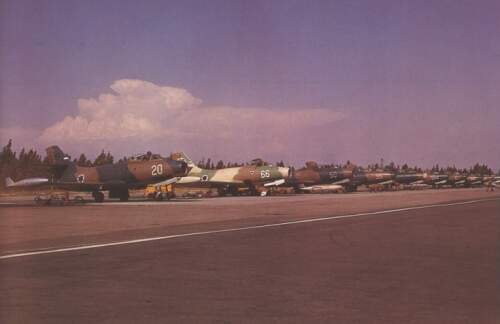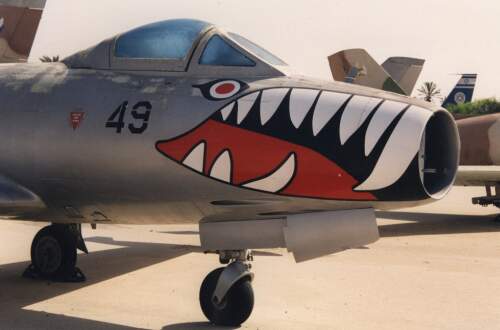Dassault M.D.450 Ouragan
 The first product of the Societe des Avions Marcel Dassault, the Ouragan (hurricane) flew for the first time on February 28th 1949. A simple but highly effective design, 350 Ouragans were built for the French air force and 194 for the Indian air force where the type was known as the Toofani.
The first product of the Societe des Avions Marcel Dassault, the Ouragan (hurricane) flew for the first time on February 28th 1949. A simple but highly effective design, 350 Ouragans were built for the French air force and 194 for the Indian air force where the type was known as the Toofani.
Israel begun arming itself with jet fighters when the air forces of Israel's Arab neighbors begun operating such aircraft. The first jet to enter service with the IAF was the Gloster Meteor in 1953, but Israel kept looking for more advanced types to add to its inventory. Various types were evaluated and attempts were made to procure such types as the F-86 Sabre or F-84F Thunderstreak, but all of these fell through, usually following Arab political intervention. The only country willing to sell fighters to Israel was France, and on July 15th 1954 a deal was signed to supply Israel with 15 Dassault Mystere IIs and 15 Mystere IVAs. This deal was soon cancelled after disappointment was sounded over the Mystere II's poor performance and Israel opted to purchase the Mystere IVA alone. The Mystere IVA, however, was not yet ready to enter service with the IAF, and faced with the problem of finding a stopgap until the IVA was available, another Dassault design was selected, the Ouragan. 12 examples were purchased, enough to equip a single squadron.
Delievery of the Ouragans begun on October 6th 1955, when the first aircraft landed in Hazor AFB, joining the newly formed 113th squadron. Middle East tensions were increasing at the time, with Arab nationality on the rise and the break between Egypt and Britain exasperating cold war tensions. At the end of September 1955 a huge weapons deal between Egypt and Czechoslovakia was anounced, a deal which included the delivery to Egypt of a hundred MiG-15 and MiG-17 jet fighters and 50 Ilyushin Il-28 bombers. Faced with the alarming prospect of facing a vastly superior adversary, the IAF purchased two dozen more Ouragans on November 4th 1955. The increasing Middle East tensions had helped to tighten relations between France and Israel and the aircraft were supplied within the month, on November 24th, out of French air force stocks.
Upon their arrival, the Ouragans replaced the Meteors as Israel's most advanced fighters, although they would play this role only for a few months, until the arrival of the Mystere IVAs in April 1956. On April 12th two Ouragans were scrambled to intercept two Egyptian De-Havilland Vampires which had penetrated Israeli air space. Scoring the world's first Ouragan kill, one of the Vampires was shot down.

Only a single Ouragan squadron equipped with 22 aircraft was operational at the outbreak of Operation "Kadesh", Israel's part in the 1956 Suez Crisis. The plans drawn up by the IAF before the crisis had called for the Ouragans to attack air fields in the Sinai in order to destroy as many Arab aircraft on the ground as possible. These plans were changed however, once fighting broke out on October 29th.
The Ouragan squadron's first mission was to escort 16 C-47s about to paradrop an Israeli battalion over the Mitla Pass, an importat strategic point in the Sinai. Throughout the war the Ouragans flew numerous missions against Egyptian ground targets, destroying dozens of enemy vehicles using 250kg bombs, napalm, air-to-ground rockets and their four 20mm cannons. On the operation's second day they flew thirty sorties over the Mitla Pass alone, besides other missions flown all over the Sinai. On October 31st six Ouragans on a ground attack mission were engaged by 8 MiG-15s. No aircraft were shot down but one was hit and returned safely to its base while another had to make a wheels-up landing after running out of fuel. In another engagement with MiG-15s, Ouragans managed to hit another MiG, earning a probable kill.
On October 31st, the Egyptian Navy destroyer Ibrahim Al Awal begun shelling Haifa, one of Israel largest cities and location of Israel's only major sea port at the time. The Egyptian destroyer manged to elude both the IAF and the Israeli Navy until it was attacked by a pair of Ouragans on the morning of November 1st. Both aircraft disabled the ship using their cannons and air-to-ground rockets, forcing it to surrender.
In all, although eight Ouragans were damaged during operation "Kadesh", not a single aircraft was downed. The type proved to be very robust and 45 more examples were procured after the war, forming a second squadron at Ramat David AFB. These were aircraft phased out of service with the French air force.
Despite the arrival of superior types such as the Super Mystere and Mirage IIIC, the Ouragans continued to play an important role as dedicated ground aircraft in the years following operation "Kadesh". In November 1964 five Ouragans participated in an attack on Syrian positions shelling Israeli settlements. On July 13th 1966 the type participated in attacks on Syrian attempts to divert the Jordan River and on November 13th in attacks against Jordanian armour.

Shark-teeth Dassault Ouragan at the IAF Museum
At the outbreak of the Six Days War on June 5th 1967 the IAF had 51 Ouragans in service, forming the "Leopard's Head" squadron at Lod and the
"Hornet" squaron at Hazor (current operator of the AH-64 Apache). The Ouragans were incorporated into
operation "Moked" and were tasked with attacking Egyptian air fields in the Sinai and near the Suez Canal. Four aircraft were hit during the operation's first attack wave, although one had managed to down an Egyptian MiG-21 before being hit by ground fire. During the operation's second and third attack waves the Ouragans participated in attacks against Jordanian and Syrian air bases as well. Following operation "Moked" which had secured Israeli control of the skies, the Ouragans also flew ground attack missions against enemy forces on all three fronts of the war, against the Egyptians in the Sinai, the Jordanians in the West Bank and the Syrians on the Golan Heights. 10 Ouragans were lost during the Six Days War, nine from ground fire while one was shot down by an Arab fighter.
The Israeli victory in the Six Days War did not bring about an end to fighting between Israel and its Arab neighbors. The eruption of the War of Attrition in late 1967 provided more opportunities for the Ouragans to fly combat missions. The type was employed against Egyptian artillery and SAMs, Jordanian and Iraqi forces in Jordan and terrorist camps in southern Lebanon. Two Ouragans were lost during this period. With the end of the War of Attrition in 1970, the remaining Ouragans were employed by the IAF Flight School to train fighter pilots. They were finally retired from service in January 1973. A dozen examples were sold to the El-Salvadorian air force in 1977.
Specification: Dassault M.D.450 Ouragan
Type: single seat fighter and fighter-bomber.
Powerplant: Hispano Suiza-built Rolls-Royce Nene Mk 104B.
Performance: max speed - 507 knots, ceiling - 13,700ft, range - 920km.
Weights: empty - 4,142m, max take off - 8,100m.
Dimensions: span - 13.07m, length - 10.74m, height - 4.14m.
Armament: 4 * 20mm cannons plus provision for 2 * 500kg bombs or 4 * 250kg bombs or 16 * 105mm rockets or 68mm rocket hives under the wings.
back to Inventory page
my email : skythe@iname.com
 back to the IDF/AF page
back to the IDF/AF page
 The first product of the Societe des Avions Marcel Dassault, the Ouragan (hurricane) flew for the first time on February 28th 1949. A simple but highly effective design, 350 Ouragans were built for the French air force and 194 for the Indian air force where the type was known as the Toofani.
The first product of the Societe des Avions Marcel Dassault, the Ouragan (hurricane) flew for the first time on February 28th 1949. A simple but highly effective design, 350 Ouragans were built for the French air force and 194 for the Indian air force where the type was known as the Toofani.

 back to the IDF/AF page
back to the IDF/AF page